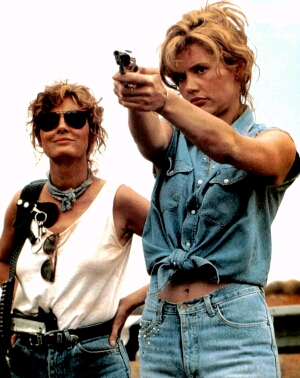
Thelma & Louise

In the two decades since its release, Thelma & Louise has been oft-imitated, never equalled. It's a sad indictment of the way Hollywood works that we have to reach back twenty years to find a successful female buddy movie, where the aim of the protagonists is NOT to find romance, and they get to chart their own destiny right up until their final exit.
Studying Thelma & Louise
A good starting point, as with any film, is the IMDb entry( Thelma & Louise) and the review round-up at Rotten Tomatoes where it gets a 92% fresh rating.
As always when studying a movie in depth, it's best to watch it all the way through once, without interruption, to feel the full effect of the film-makers' intentions.
Then it's back to the beginning for some more in-depth analysis. Here are a few questions to start you off.
|
The Opening Sequence |
|
|
Introduction of the Two Lead Characters |
|
|
The Rape Scene |
|
|
The Closing Sequence |
|
Characterisation and use of Stars
Thelma and Louise revolves around the central characters. Sarandon and Davis are generally praised for the strength of their performances, but what qualities do they bring to the roles? Apply the commutation test - would different actors have created a drastically different Thelma and Louise? Michael Madsen and Harvey Keitel also appeared together in Reservoir Dogs (1992), in roles which were perhaps more in keeping with their developing star personae. Do you think they would have taken the parts in Thelma & Louise after the success of Reservoir Dogs?
Representation and Audience Response

Do Thelma and Louise mean different things to different audiences? Male and female audiences are often perceived to read the film, and the main characters, very differently. Are Thelma & Louise gutsy heroines who triumph over the boorish, stupid men surrounding them, or are they criminals pitted only against cartoon males? If we think of characters as receptacles for audience's emotions, what do Thelma & Louise receive and what do they reflect back. Is their characterisation sexist in any way?
In class we looked at the comparisons between Thelma & Louise and conventional buddy movies, especially Butch Cassidy & the Sundance Kid. Are Thelma and Louise original characters, or simply 'remakes'? Does their characterisation bring anything new to the genre of the buddy movie, or does it simply replace the male stereotype with a female who conforms to the stereotype in everything but her biological gender?
Style
Ridley Scott has amassed an impressive body of work as a film-maker, as both director and producer. He began by directing TV adverts, and has since been responsible for a wide variety of films, from the futuristic science fiction of Alien and Blade Runner to the sweeping historical epic Gladiator, to gritty urban drama in American Gangster. He is clearly a director to whom spectacle is very important - what do you think his aims are when creating a movie?
- Do you think he has a distinctive directing style and can this be seen in Thelma & Louise? If not, why not?
- Do you think the criticisms contained in this review are fair?
- What is the role of the cinematographer, Adrian Biddle, and how does T&L compare to his other work?
- How important do you think visual style is to an audience's reading of Thelma and Louise? Think particularly about genre, and how the action shifts from a domestic/urban setting to the mythical space of the Wild West. How is that transition effected?
- How does Scott handle the 'set pieces' of the film (car chases, explosions etc) where he is not relying on scripted dialogue, but on his own interpretation of a stage direction such as "They are chased across the desert by a lot of police cars"?
- Why do you think Scott was attached to this project? In your opinion, was he a suitable director? What might a female director working at the time such as Kathryn Bigelow or Mary Harron have brough to the project?
Commercial Considerations
Thelma & Louise is a studio production. Ensure you are clear on the differences between a studio and an independent production:
- In your opinion, could Thelma & Louise have successfully been made as an independent production? Would it have been a different movie — in what ways?
- How was Thelma & Louise marketed? Ensure you can analyse accurately and in detail a) the poster and b) the trailer
- What was the target audience of Thelma and Louise? How was the marketing campaign designed to reach them?
- What does the business data you have tell you about the success of Thelma & Louise? What does the pattern of box office returns tell you about the way the movie was a) promoted and b) received by the public?
Themes and Issues
Can you write about the following themes and how the Thelma & Louise screenplay explores them?
- Escape/Freedom
- Feminism
- Fantasy
- Crime and Punishment
- Repression/Empowerment
- Gender
- Genre Expectations
- Transformation
At the end of the day, whether you personally feel Thelma & Louise is a good movie or not, it has important cultural significance, transcends genre boundaries, and over time has become an ideal of female empowerment on screen.